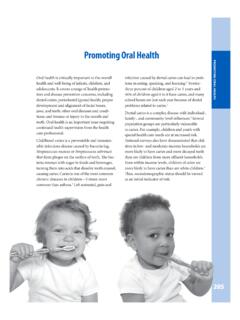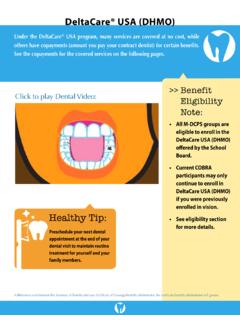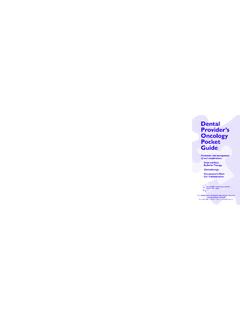Transcription of Diet and Oral Health: Factsheet on oral health and sugars
1 diet and oral health Unhealthy diet and poor nutrition affect the teeth and growth of the jaws during development and later during the life-course. The most significant effect of diet is in the mouth, particularly in the development of dental caries (Fig. 1 and 2) and enamel erosion. dental erosion is associated with dietary acids, of which a major source is soft drinks. Factsheet . Scientific evidence shows an association between intake of free sugars and dental on oral health and caries . Nutritional status affects teeth pre-eruptively, though this is less important than sugars intake the post-eruptive local effect of diet .
2 Undernutrition, coupled with a high intake of sugars , may exacerbate caries . dental caries and obesity are strongly linked due to common dietary risk factors. dental diseases and tooth loss have a considerable impact on self-esteem, ability to eat, nutrition and health both in childhood and older age. In older people, extensive tooth loss may limit intake of healthy foods, impair nutrition and increase the risk of chronic diseases. Key facts Tooth decay ( dental caries ) is the most common noncommunicable disease in Europe. Severe dental caries may lead to pain and discomfort. dental caries impacts nutrition, general health and quality of life.
3 dental caries is a frequent cause of absenteeism at work or school. dental caries and obesity are linked due to common risk factors. Free sugars1 are a crucial causal factor in the development of tooth decay and obesity. Confectionery, cakes, biscuits, sweetened cereals, sweet desserts, sucrose, honey and preserves are the most common sources of free sugars . Fig. 1. Child dental caries Sugar-sweetened drinks, including fruit juices and milk-based sweetened drinks, contain free sugars . Other foods such as bread, pasta sauce and soups also contain free sugars . As recommended by WHO, limiting free sugars intake to less than 10% and ideally even further to less than 5% of total energy intake minimizes the risk of diet -related disease throughout the life-course.
4 _____. 1. Free sugars include all monosaccharides and disaccharides added to foods and drinks by the manufacturer, cook or consumer, and sugars naturally present in honey, syrups, fruit juices and fruit juice concentrates (WHO Guideline on sugars intake for adults and children: ). Fig. 2. Painful, severe early childhood caries public health problems Diseases of the mouth are a highly prevalent noncommunicable disease in European countries. Between 20% and 90% of 6-year-old children have dental caries , and at age 12, an average of permanent teeth are affected by this disease. In European countries, nearly 100% of adults have experience of this disease and between the ages of 35 44 years, an average of 10 20 teeth have dental decay (Fig.)
5 3 and 4). dental caries is a major cause of complete loss of natural teeth and this condition affects 30% of older Europeans in the age group 65 74 years. The prevalence rate of older people having lost all their Fig. 3. Adult dental caries of lower natural teeth varies by country from 5% to 51%. jaw teeth Inequity in oral health Across Europe the disease conditions are particularly frequent or severe among underprivileged and disadvantaged population groups, and socioeconomic factors also play a crucial role in the scope of services covered by primary oral health care. In many countries, both poor children and adults are underserved by dental care since access to dental care is not equitable.
6 Economic burden Diseases of the mouth are a costly burden to health care services. The treatment of dental diseases is expensive, accounting for between 5% and 10% of total public health care expenditures in European countries. In the European Union, the annual cost of dental care is estimated at 79 billion euros. Fig. 4. Adult dental caries of upper jaw what is happening? dental caries , dental erosion and periodontal disease are major dental diseases. dental caries dental caries (cavitation) occurs due to loss of tooth substance (enamel and dentine) by acids formed by bacteria in so-called dental plaque.
7 This process is due to the bacterial metabolism of sugars derived dental caries from the diet . Early stages of dental caries are often without symptoms, while advanced stages of - a prevalent dental caries may lead to pain, infections and abscesses, or even sepsis. Advanced stages often chronic disease result in tooth extraction (pulled out). The development of caries is influenced by the susceptibility dental caries is a major of the tooth, bacterial profile, quantity and quality of the saliva, low levels of fluoride, and amount or cause of complete loss frequency of intake of sugars . of natural teeth and this condition affects 30% of Poor salivary flow or salivary deficiencies make some individuals more susceptible to dental disease.
8 Older Europeans in the age group 65 74 years. dental erosion The prevalence rate dental erosion is the progressive irreversible loss of tooth substance that is chemically etched away of older people having from the tooth surface by dietary extrinsic and/or intrinsic acids. Erosion reduces the size of the teeth lost all their natural and in severe cases leads to total tooth destruction. teeth varies by country from 5% to 51%. Periodontal disease The main overriding factors of periodontal disease are poor oral hygiene and the use of tobacco. In addition, evidence shows an association between diet and periodontal disease.
9 Severe vitamin C. deficiency may result in scurvy-related periodontitis. Malnutrition may also exacerbate periodontal and oral infectious diseases. Examples of sugar-rich foods and drinks Confectionery, cakes, biscuits, sweetened cereals, sweet desserts, sucrose, honey and preserves are common sources of free sugars . Sugar-sweetened beverages, including fruit-based and milk-based sweetened drinks and 100% fruit juices, are a primary source of free sugars . Common foods and drinks Sugar TSP Common foods and drinks SugaR tsp Snickers bar ( g) Carrot cake (1 medium slice) 3 Musketeers bar (60 g) Chocolate mousse (1 medium portion) Milk chocolate M&M's ( g) Fruitcake (1 medium slice) Ice cream (1 scoop) Coca-Cola (one can) Honey Smacks (per 100 g) Pepsi-Cola (one can) Golden Grahams (per 100 g) Sprite (one can) Cocoa Puffs (per 100 g) what can we do about it?
10 The WHO Guideline on sugars intake for adults and children, published in March 2015, includes a strong recommendation for both adults and children to reduce daily intake of free sugars to less than 10% of total energy intake. A further reduction to below 5% of total energy intake would protect oral health throughout the life course. In addition, adequate exposure to fluoride should be promoted to prevent dental caries . prevention is the key to health Population-wide strategies to reduce free sugars consumption are the key public health approach that should be prioritized as a matter of urgency. Implementation of public health strategies to promote appropriate exposure to and use of fluoride should be encouraged.
















